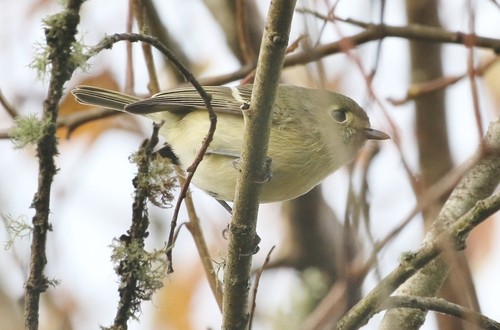Hutton's Vireo
A species of Vireos Scientific name : Vireo huttoni Genus : Vireos
Hutton's Vireo, A species of Vireos
Botanical name: Vireo huttoni
Genus: Vireos
Content
Description People often ask General Info
 Photo By silversea_starsong , used under CC-BY-NC-4.0 /Cropped and compressed from original
Photo By silversea_starsong , used under CC-BY-NC-4.0 /Cropped and compressed from original Description
Hutton's vireo (Vireo huttoni) is a small songbird. It is approximately 5 inches (12–13 cm) in length, dull olive-gray above and below. It has a faint white eye ring and faint white wing bars. It closely resembles a ruby-crowned kinglet, but has a thicker bill and is slightly larger in size. Its most common song is a repeated chu-wee, or a chew, but will have other variations. Its call is a mewing chatter. It is found from southern British Columbia in Canada to central Guatemala in Central America. Recent DNA studies suggest this species may be split into at least 2 different species, with coastal Pacific birds showing enough genetic variation when compared to interior ones. This vireo makes a hanging cup nest suspended from a fork of a tree. The female lays 3–4 eggs. The eggs are mostly white in color, with scattered brown spotting. It prefers deciduous-mixed forests, and is particularly fond of live oak. It feeds by gleaning insects as it deliberately moves through the forest canopy. Birds are mostly resident year-round, but there may be some altitudinal and short distance migration. Hutton's vireo may join a mixed-species flock for the winter. The scientific name commemorates the US surveyor William Rich Hutton. 
Size
12-13 cm (4.75-5 in)
Life Expectancy
6.5-13.5 years
Nest Placement
Tree
Clutch Size
1 - 5 eggs
Incubation Period
1 brood
Number of Broods
14 - 16 days
Feeding Habits
Hutton's Vireo forage methodically through tree foliage for insects and spiders, often at considerable heights, while also pursuing flying insects. They consume a variety of prey like bugs, hoppers, beetles, weevils, caterpillars, and supplement their diet with buckthorn, poison oak, elderberry berries, and sapsucker well sap.
Habitat
Hutton's Vireo typically thrives in extensive coniferous, oak, and mixed forests, spanning climates from coastal to montane regions. They prefer habitats featuring evergreen oaks, with a broad altitudinal range up to 11,800 feet. In the Pacific Northwest, hutton's Vireo can be found among spruce, hemlock, and Douglas-fir, while in California, they inhabit redwood, fir, and varied pine forests. Additionally, in the southwestern U.S., Mexico, and Guatemala, hutton's Vireo occupies pine, fir, and mixed pine-oak-juniper woodlands.
Nest Behavior
Both hutton's Vireo parents construct the nest, with probable site selection by the female. They breed and lay eggs seasonally, and cooperatively engage in incubating and raising their young, sharing responsibilities.
Nest Characteristics
Hutton's Vireo's nest, often in a twig fork near a branch end and typically veiled by foliage or lichen, is a suspended cup located about 16 feet up, in oak or conifers. The 3-inch-wide nest is amalgamated with moss, lichen, grass, spider cocoons, feathers, and bark, bound by spiderweb.
Dite type
Insectivorous
People often ask
General Info
Feeding Habits
Bird food type
Bird Feeder Type

Small Hopper

Small Tube Feeder
Sounds
Call
Recording location: Mexico
Song
Recording location: Mexico
Song
Recording location: Mexico
Song
Recording location: Mexico
Behavior
Hutton's Vireo exhibit a strong sense of companionship, often found in pairs throughout the year which indicates potential monogamous pair bonding. These pairs sometimes join mixed-species flocks, displaying an adaptable social behavior. Males vigorously defend their territory, especially in spring during the breeding season, and both sexes participate in nest activities. Hutton's Vireo have a distinctive agitated wing-flicking behavior. Their territories average between 1.7 to 7.2 acres. Courtship includes unique displays by the male, such as tail spreading and body fluffing, accompanied by specific calls. The species is characterized by cooperative incubation and chick-rearing, ensuring a shared role in offspring development.
Species Status
Not globally threatened.